

Wheeling High School: A P21 21st Century Learning Exemplar. Spirit Lake High School: A P21 21st Century Learning Exemplar. Not Old School: Architecture in Support of Learning. Furniture Craftsmanship. Flexible Learning Spaces Foster Project-based Learning. By Justin Dent and Dr.
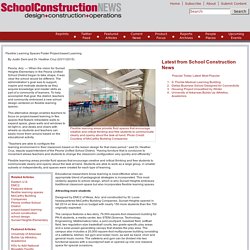
Heather Cruz (03/11/2015) Flexible learning areas provide fluid spaces that encourage creative and critical thinking and free students to communicate clearly and openly about the task at hand. Photo Credit: Courtesy of McCarthy Building CompaniesPeoria, Ariz. — When the vision for Sunset Heights Elementary in the Peoria Unified School District began to take shape, it was clear the school would be different. The administration’s goal was to support, inspire and motivate students as they acquire knowledge and master skills as part of a community of learners. To help accomplish that goal, the district, teachers and community embraced a new school design centered on flexible learning spaces. ”Teachers are able to configure the learning environment in their classroom based on the lesson design for that class period,” said Dr. Facilities. High Tech High facilities are developed and owned by HTH Learning, a private non-profit supporting the development of HTH schools.
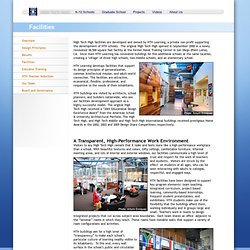
The original High Tech High opened in September 2000 in a newly renovated 38,500 square foot facility at the former Naval Training Center in San Diego (Point Loma), CA. Since then HTH Learning has renovated buildings for five additional schools at the same location, creating a "village" of three high schools, two middle schools, and an elementary school. HTH Learning develops facilities that support its design principles of personalization, common intellectual mission, and adult-world connection. 2014 Education Trends Require Flexible Classrooms - and Attitudes - Smith FilesSmith Files. 2014 Education Trends Require Flexible Classrooms — and Attitudes By: Michael Risdall For most people, the word “flexibility” conjures up images of impossible yoga poses.

But in the K-12 education arena, that word has proven to be a perennial favorite on education trend lists, including those for 2014. Take a quick scan and you’ll see education magazines, bloggers and other social media messengers flooding us with trend forecasts that stress the need for flexible classrooms. That voice will only grow louder as the Common Core State Standards (CCSS) spread.
Common Core Driving Design. Furniture Expo Sets Stage for 21st Century Learning Spaces. Sitting down at flexible tables with swivel chairs and tablet compartments, students, teachers and parents moved quickly from one piece of furniture to the next to see which ones were the most comfortable and collaborative.
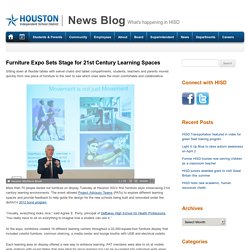
More than 70 people tested out furniture on display Tuesday at Houston ISD’s first furniture expo showcasing 21st century learning environments. The event allowed Project Advisory Teams (PATs) to explore different learning spaces and provide feedback to help guide the design for the new schools being built and renovated under the district’s 2012 bond program. “Visually, everything looks nice,” said Agnes E. Perry, principal of DeBakey High School for Health Professions. “You really have to sit on everything to imagine how a student can use it.” At the expo, exhibitors created 19 different learning centers throughout a 22,000-square-foot furniture display that included colorful furniture, common shelving, a media center and lounge booths with USB and electrical outlets. Flexible learning space…
I had a great discussion with a colleague the other day, about the new flexible learning spaces at our junior campus.
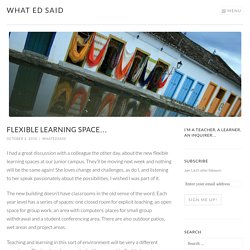
They’ll be moving next week and nothing will be the same again! She loves change and challenges, as do I, and listening to her speak passionately about the possibilities, I wished I was part of it. The new building doesn’t have classrooms in the old sense of the word. Each year level has a series of spaces: one closed room for explicit teaching, an open space for group work, an area with computers, places for small group withdrawal and a student conferencing area. There are also outdoor patios, wet areas and project areas. Flexible learning space.
I had a great discussion with a colleague the other day, about the new flexible learning spaces at our junior campus.
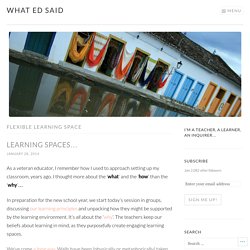
They’ll be moving next week and nothing will be the same again! She loves change and challenges, as do I, and listening to her speak passionately about the possibilities, I wished I was part of it. The new building doesn’t have classrooms in the old sense of the word. Each year level has a series of spaces: one closed room for explicit teaching, an open space for group work, an area with computers, places for small group withdrawal and a student conferencing area. There are also outdoor patios, wet areas and project areas. Why bother with Flexible Learning Spaces ? - Flexible Learning Space.
Flex·i·ble/ˈfleksəbəl/Adjective learn·ing/ˈlərniNG/Noun space/spās/Noun Flexible Learning Space: ...large unformated area for learning ...place where furniture and technology are easily changed to the meet the learners' requirements.

Benefits of Flexible Learning Spaces #1 Teaching in Teams. Flexible or open learning spaces are hard work.

It is a challenge for teachers to adapt their practices, it is a challenge for students to adapt their behaviour. The benefits are unparalleled though, and can be translated back into any learning space. Teachers working in teams is a significant benefit that arises from teaching in an open learning space. Teachers have the opportunity to learn from others in the following ways:
EAA Flexible Blended Learning Spaces. Five Detroit schools utilize flexible learning spaces to accelerate student learning.
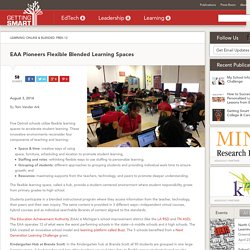
These innovative environments reconsider four components of teaching and learning: Space & time: creative ways of using space, furniture, scheduling and location to promote student learning;Staffing and roles: rethinking flexible ways to use staffing to personalize learning;Grouping of students: different approaches to grouping students and providing individual work time to ensure growth; andResources: maximizing supports from the teachers, technology, and peers to promote deeper understanding. The flexible learning space, called a hub, provide a student-centered environment where student responsibility grows from primary grades to high school. Students participate in a blended instructional program where they access information from the teacher, technology, their peers and their own inquiry.
Kindergarten Hub at Brenda Scott. SCL Village at Phoenix. The Middle School Hubs at Nolan. Tennessee Teaching and Learning Center (TennTLC) Flexible classrooms are learning spaces designed to encourage student interaction, to engage them with active learning techniques and thereby create the opportunity for retention and transfer of knowledge and deeper learning.
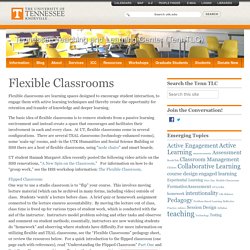
The basic idea of flexible classrooms is to remove students from a passive learning environment and instead create a space that encourages and facilitates their involvement in each and every class. At UT, flexible classrooms come in several configurations. There are several TEAL classrooms (technology-enhanced rooms), some ‘scale-up’ rooms, and–in the UTK Humanities and Social Science Building or HSS there are a host of flexible classrooms, using “node chairs” and smart boards. UT student Hannah Margaret Allen recently posted the following video article on the HSS renovations, “A New Spin on the Classroom.” For information on how to do “group work,” see the HSS workshop information: The Flexible Classroom. Understanding student learning in flexible learning spaces - Learning Spaces and Learning Styles. Flexible Learning Spaces. Skip to main content Flexible Learning Spaces There is a vast body of research that supports the benefits of flexible learning spaces.
Much of this work discusses the enormous changes in the world, the increasing pace of that change, and how schools need to change their approach to better equip young learners for the world in which they will live. The following links provide a number of, hopefully thought provoking, videos to help you come to understand the rationale behind the approach. This will be an ever increasing resource - so check back often! 1. 2. 3. 4.The classroom of the future – a compilation of a variety of options. Pinterest. Creating an Ultra-Flexible Learning Space. Classroom Evolved | Feature Creating an Ultra-Flexible Learning Space By Bridget McCrea02/08/12 Designers of the Minnesota School of Environmental Studies (SES) were years ahead of the curve when it came to creating collaborative classrooms that would one day accommodate learning technologies that in 1995 had yet to be conceived--let alone developed and marketed to the educational sector.
More affectionately known as "The Zoo School" owing to its location adjacent to the Minnesota Zoo in Apple Valley, MN, the optional high school's design centered on student learning needs, classroom teaching scenarios, and project learning with an environmental theme. "We challenged the architect [Bruce Jilk of KKE Architects in Minneapolis] to design a facility that would match how we felt learning would occur in the new facility," said Dan Bodette, SES' principal. Workstations, Pods, and Houses At the core of that design philosophy is an individual workstation for each of SES' 400 students.
Flexible Learning Environments. Creating Flexible Learning Environments. Design Ideas: Flexible Learning Environments. By Daniel Mader, AIA, REFP, LEED AP As printed in American School & University Classroom design soon will be dramatically different from what we see in schools today. The evolution of the classroom will be driven by technological advances and changes in instructional approaches—influences that already are impacting the design of new and modernized schools. Even the term “classroom” will become a misnomer, as the space essentially will serve as a flexible learning environment. The most basic change will be in overall size. Classrooms, or learning environments, typically will be at least 1,400 to 1,500 square feet, as opposed to the more common 800 to 900 square feet. Instruction will move away from the traditional, lecture-style approach in which teachers stand at the front of the classroom and address students seated at rows of desks.
This sort of animated, interactive approach to education not only requires more space, but also merits built-in flexibility.